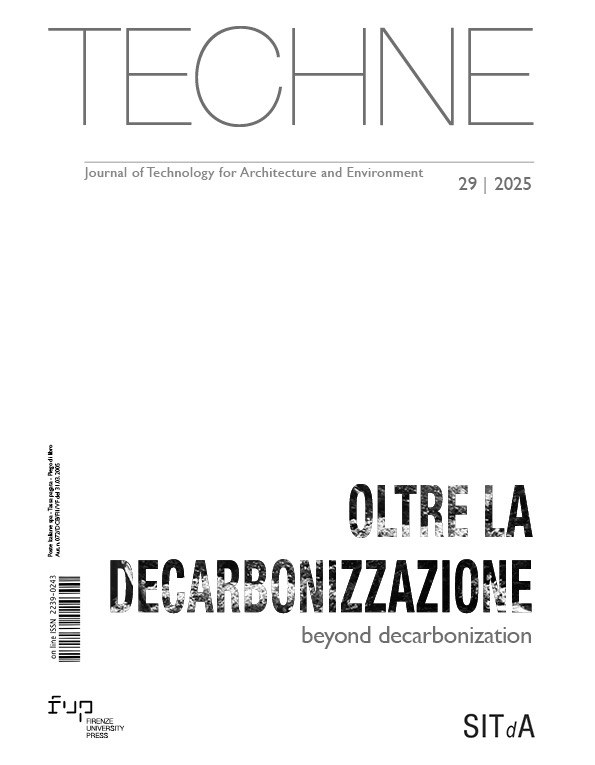Published 2025-07-31
Keywords
- Thermal comfort,
- Evaporative-cooling,
- Liveability,
- Climate adaptation,
- Holistic cross-scalar approach
How to Cite
Copyright (c) 2025 Mariana Pereira Guimaraes, Valentina Dessì

This work is licensed under a Creative Commons Attribution 4.0 International License.
Funding data
-
Horizon 2020 Framework Programme
Grant numbers 86119
Abstract
The paper presents a methodology for adapting to urban overheating by creating strategically located blue-green oases – combining vegetation and water systems to enhance neighbbourhood thermal comfort. Focusing on Milan’s Corvetto district as an example, the methodology includes 1) identifying socio-environmentally vulnerable neighbourhoods at the city scale; 2) mapping existing cool spots within the neighbourhood; 3) identifying areas beyond a 5-minute walking radius from these cool spots; and 4) proposing local interventions, such as water-based solutions (WBS), in urban spaces that could become new “cool spots”. The results highlight a network of potential new cooling spaces.
Downloads
References
- Cremonini, L. et al. (2023), “Tools for urban climate adaptation plans: A case study on Bologna and outcomes for heat wave impact reduction,” Challenges, Vol. 14, n. 4, article 48. Available at: https://dx.doi.org/10.3390/challe14040048 (Accessed on 22/11/2024). DOI: https://doi.org/10.3390/challe14040048
- Coffin, A.M. and Morrall, J., (1995), “Walking speeds of elderly pedestrians at crosswalks”, Transportation Research Record, Vol. 1487, pp. 63-67. Available at: http://onlinepubs.trb.org/Onlinepubs/trr/1995/1487/1487-010.pdf (Accessed on 21/05/2023).
- De Ridder, K., Lauwaet, D. and Maiheu, B. (2015), “UrbClim – A fast urban boundary layer climate model,” Urban climate, Vol. 12, pp. 21–48. Available at: https://dx.doi.org/10.1016/j.uclim.2015.01.001 (Accessed on 22/11/2024). DOI: https://doi.org/10.1016/j.uclim.2015.01.001
- European Environment Agency – EEA (2020), Report No 12/2020: Urban adaptation in Europe: how cities and towns respond to climate change. Available at: https://www.eea.europa.eu/publications/urban-adaptation-in-europe (Accessed on 13/02/2021).
- Gobster, P. H. (2001), “Neighbourhood – Open Space Relationships in Metropolitan Planning: A look across four scales of concern,” Local environment, Vol. 6, n. 2, pp. 199–212. Available at: http://dx.doi.org/10.1080/13549830120052827 (Accessed on 22/11/2024). DOI: https://doi.org/10.1080/13549830120052827
- Höppe, P. (1999), “The physiological equivalent temperature – a universal index for the biometeorological assessment of the thermal environment,” International Journal of Biometeorology, Vol. 43, n. 2, pp. 71–75. Available at: https://dx.doi.org/10.1007/s004840050118 (Accessed on 22/11/2024). DOI: https://doi.org/10.1007/s004840050118
- Intergovernmental Panel on Climate Change – IPCC (2018), Summary for Policymakers. In: Global Warming of 1.5°C. World Meteorological Organization, Geneva, Switzerland, pp. 1-32. Available at: https://www.ipcc.ch/sr15/chapter/spm/ (Accessed on 20/01/2021).
- Klok, L. et al. (2021), “Application and performance of Kestrel sensors for assessing thermal comfort in outdoor built environments”. EGU General Assembly 2021, online, April 19–30, 2021, EGU21-13237. Available at: https://dx.doi.org/10.5194/egusphere-egu21-13237 (Accessed on 09/12/2022). DOI: https://doi.org/10.5194/egusphere-egu21-13237
- Kluck, J. et al (2020), Report: De hittebestendige stad: Een koele kijk op de inrichting van de buitenruimte (in Dutch) [The heat-resistant city: A cool look at the design of the outdoor space]. Amsterdam University of Applied Sciences. Available at: https://edepot.wur.nl/522616 (Accessed on 23/10/2022).
- Koopmans, S. et al. (2020), Report: Validatierapport Landelijke hittekaart (in Ducth) [National Heat Map Validation Report]. Wageningen University, Meteorology and Air Quality Section, pp. 1–26. Available at: https://www.klimaateffectatlas.nl/l/nl/library/download/urn:uuid:c13d0006-131b-4d90-8f2be1c6834d2d6d/validatierapport+landelijke+hittekaart_wur_wb_9juli2020.pdf? (Accessed on 09/12/2022).
- Martiello, M.A. et al (2008), “Effetti sulla salute delle ondate di calore” (in Italian) [Health effects of heat waves]. Igiene e sanita pubblica, Vol. 64, n. 6, pp. 735–772. Available at: https://pubmed.ncbi.nlm.nih.gov/19219085/ (Accessed on 09/12/2023).
- Nuijten, D., (2008). “Verplichte vergroening? Onderzoek naar de toepassing van het richtgetal van 75 m2 groen per woning uit de Nota Ruimte en de relatie met de kwaliteit van het groen in de stad” (in Dutch) [Mandatory greening? Research into the application of the guideline figure of 75 m2 of green space per home from the Spatial Planning Policy Document and the relationship with the quality of greenery in the city]. Masterproef Sociaal-Ruimtelijke Analyse [Master’s thesis Social-Spatial Analysis], Wageningen University, pp. 1–117. Available at: https://edepot.wur.nl/117429 (Accessed on 12/03/2024).
- Pascal, M. et al. (2021) “Greening is a promising but likely insufficient adaptation strategy to limit the health impacts of extreme heat,” Environment International, Vol. 151, article 106441. Available at: https://dx.doi.org/10.1016/j.envint.2021.106441 (Accessed on 22/11/2024). DOI: https://doi.org/10.1016/j.envint.2021.106441
- Pereira Guimarães, M., Dessì, V. (2022), “A Multi-functional Design Approach to Deal with New Urban Challenges”. In Sustainability in Energy and Buildings 2021. Smart Innovation, Systems and Technologies, vol 263. Springer, Singapore. Available at: https://doi.org/10.1007/978-981-16-6269-0_33 (Acessed on 22/11/2024) DOI: https://doi.org/10.1007/978-981-16-6269-0_33
- Pasqui, G. (2022) “Inequalities: Peripheries,” in Coping with the Pandemic in Fragile Cities. Springer Briefs in Applied Sciences and Technology. Cham: Springer International Publishing, pp. 45–54. Available at: https://dx.doi.org/10.1007/978-3-030-93979-3_5 (Accessed on 22/11/2024). DOI: https://doi.org/10.1007/978-3-030-93979-3_5
- Ulpiani, G., di Perna, C. and Zinzi, M. (2019) “Water nebulization to counteract urban overheating: Development and experimental test of a smart logic to maximize energy efficiency and outdoor environmental quality,” Applied Energy, Vol. 239, pp. 1091–1113. Available at: https://dx.doi.org/10.1016/j.apenergy.2019.01.231 (Accessed on 22/11/2024). DOI: https://doi.org/10.1016/j.apenergy.2019.01.231
- Xue, F. et al. (2015) “Modeling the influence of fountain on urban microclimate,” Building Simulation, Vol. 8, n. 3, pp. 285–295. Available at: https://dx.doi.org/10.1007/s12273-014-0210-7 (Accessed on 22/11/2024). DOI: https://doi.org/10.1007/s12273-014-0210-7
- World Health Organization (2016). Report: Urban green spaces and health. WHO Regional Office for Europe, Copenhagen. Document number: WHO/EURO:2016-3352-43111-60341. Available at: https://iris.who.int/handle/10665/345751(Accessed on 22/05/2020).
- Zinzi, M. et al. (2020) “On the thermal response of buildings under the synergic effect of heat waves and urban heat island,” Solar Energy, Vol. 211, pp. 1270–1282. Available at: https://dx.doi.org/10.1016/j.solener.2020.10.050 (Accessed on 22/11/2024). DOI: https://doi.org/10.1016/j.solener.2020.10.050






